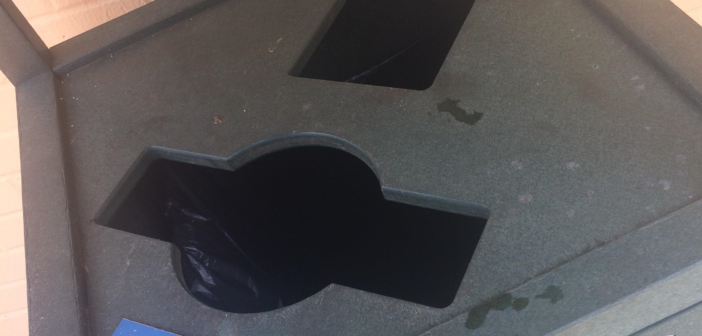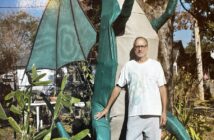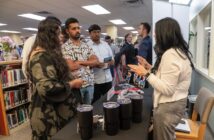There is a serious problem in the United States concerning recycling. The issue in America is that there is not enough recycling being done across the nation to make enough of an impact.
Jose Caban, Associate Vice President for Facilities at Saint Leo University, realizes this issue and is committed to doing something about it. Caban said there is currently no recycling program being done across campus but is making it a priority to change this and has a few ideas how this can be done.
First, Caban explained how recycling has evolved on campus. He says that 2007 to 2009 was the pinnacle of recycling as it became popular across America.
“Back in 2007, we were doing minimal recycling. We had little blue containers in offices, and they were collecting paper—just office paper. They would bring it to a container and once or twice a week, depending on the level of volume, we would have a group of guys, usually a student worker, who would go on a golf cart and use a wheel barrel and put it on a cart and take it to the plant. The plant is where we have the containers, and they would put it into a large container, and once a month they would pick that up and recycle the paper,” mentioned Caban.
Being environmentally conscience gained popularity when the first law in favor of recycling was made in San Francisco in 2007, which banned grocery stores from distributing plastic bags. Also, at this time, five states passed laws forcing businesses to recycle their unwanted electronics, instead of throwing them out, according to Busch Systems.
Caban also mentioned that when Plant Operations were recycling in the early 2000s, they were being paid a fee because the materials the plant collected were being sold. During this time, there were bottles, cans, cardboard, light bulbs, scrap metal, plastic and anything else the University could think of to be recycled.
The University was spending about $50,000 a year in trash/recycling, and Caban said the University stuck it out through the high costs because it was the right thing to do.
Caban explained, “We had a bunch of students who were engaged and involved, who reported to facilities. They came in and went to collection points on campus with golf carts we gave to them to help make it easier. It was great, wonderful even. But you don’t have that kind of engagement with every class. Some students were really into the recycling and some students, not so much. We would have to pay another person at $11.50 full time plus benefits to do that position, which really requires two people to do, because of the sheer weight and volume. We would be somewhere around $70,000 to the University; on top of the $50,000 that we were paying in fees. So, it didn’t make sense financially to do that. So, we would have student workers to do it.”
However, this has since changed due to the amount of labor it took to decipher the materials. Another factor to the change was due to recyclables becoming contaminated from garbage being thrown away into the recycling bins instead of the regular garbage bins.
According to USA Today, one of the main issues involved in low percentage recycling is inconsistent labels confusing to the public. This confusion then results in garbage being accidentally thrown in the recycling bin, instead of the designated garbage bin.
These mix-ups cause several problems for the workers who are in charge of the recycling process at the plants. An example of an item being placed in the wrong bin would be a garden hose being placed in the recycling bin, which would then get onto the conveyor belt at a recycling facility. These kinds of mistakes can lead to tangles in the waste process, causing the workers to stop and manually remove the hose.
Such issues then cause the recycling companies to raise and add fees for contaminated bins due to the extra labor it takes to go through the items.
Saint Leo facilities have attempted several initiatives to stop getting recyclables contaminated. For the past few years, Plant Operations have set out blue containers close to the residential halls, hoping the students would take the initiative to separate their trash from recycling.
Facilities also tried putting containers near the compactors that had slots for specific recyclable items, such as cardboard, plastic bottles and aluminum cans. However, this did not work either as people would throw garbage in there when the compactor was full.
When the bins were collected and taken to the plant in Tampa, they would find the garbage and bill the University for a contaminated container.
Doctor Ondrovic, associate professor of biology and physics, is aware of these issues campus has been having with contaminated bins.
“It only takes one individual who discards food waste in the recyclables, contaminating the entire container. Unfortunately, this requires the contractor to discard the entire container, as it is too costly and sometimes impossible to clean the raw materials being recycled. If this happens too often, that contractor will refuse your recycling. So, it only takes one person to ruin the efforts of many,” said Ondrovic.
These constant fallbacks prompted Caban to meet with waste management manager, Karen Bryant. They made the collective decision to switch to a single stream recycling system.
Single stream is when all recyclable items are put into a single bin; then is sent off to a Materials Recovery Facility. This facility is where the items are sorted through and sold to places where it will be manufactured into new products, according to Container Recycling Institute.
Ondrovic mentioned single source streams are very helpful, and that education is key for a solution to end confusion over recyclable and unrecyclable items.
Caban also believes education is a must and admits that opening recycling bins up to everyone is the biggest challenge, for that reason. He mentioned there has been talk about integrating recycling as an SLU 100 course, as he believes recycling on campus needs to be taught to students from day one.
He listed other ways they have already tried to help the situation such as putting out residence life notices, held mini classes/discussions, distributed flyers and made very specific labels on bins.
However, even with all of these attempts, there was still trash contaminating the recycling and recycling cost increased over time.
“We have learned something new every school year. Costs are going up, and recycling is not working. The image we had was that, yes, we were recycling, but they kept billing us. We got to $160,000 in less than 10 years in bills. So, when you weigh the benefits to recycling, it just wasn’t cost effective. It didn’t make any sense anymore,” admitted Caban.
These realizations caused Caban and his team to stop recycling, except in Plant Operations. Caban believes in recycling and that there should be a recycling program on campus, but the expenses are too substantial. The University is currently saving about $90,000 this year due to not recycling.
The question, however, still stands: what can be done?
Caban and his team are still brainstorming ways for the University to be successful when recycling. He thinks it is very important to have a recycling committee and create a program that works for everyone on campus.
He said there will need to be protocols where bins are collected, sorted through and sent off to a recycling plant. This would then eliminate contaminated bins being sent to the plant, therefore the University not being billed.
Caban also mentioned that he would love to have a monitor that has a graph showing students the amount of trash and electric generated, which would be updated every day.
He said for any of these initiatives to work they will need students’ help; facilities can pay students through work study. Also, Caban would like to create a small compound dedicated to separating recycling, where all of the recyclables would be taken daily, and then the items would then be separated by the University. This would then eliminate the risk of a contaminated bin going to the recycling plant, therefore making it more cost-friendly as the university would not get billed.
Caban hopes to start another recycling program either this summer or this coming fall. Caban and Jerry Grocholski, Executive Coordinator for Facilities Management, are committed to helping the University succeed in all areas, including going green.
Ondrovic mentioned that recycling is a must in our current environmental society. He adds that people are already having issues finding areas dispose of garbage. Not to mention landfills add a lot of environmental issues.
He also added that a good alternative is repurposing items as it cuts down on costs for collection and manufacturing of new items. An example of this is him reusing yogurt cups as pots for seeding in his garden.
As said before, Caban is very dedicated to initiating a recycling program on campus that works for everyone. He hopes he and the rest of his team can come up with something to start the new school semester.
“We’re committed and here to help. But it requires a full-time group of people to be able to be successful. And I think with students working with us, there is no way we can’t succeed,” Caban said.





